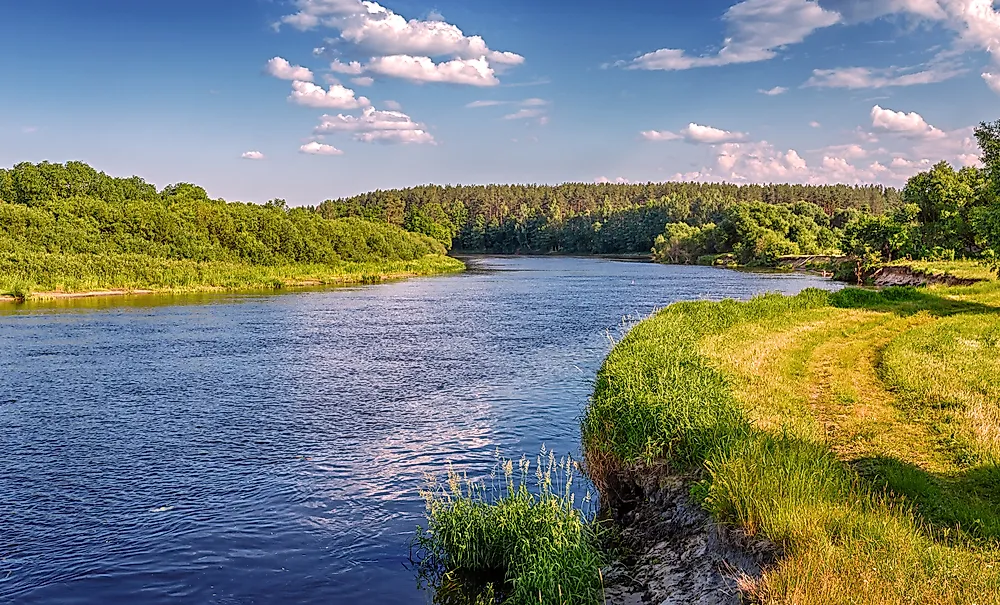Major Rivers Of Belarus

Belarus is an Eastern European landlocked country that has a vast number of water bodies including more than 20,000 rivers. The major rivers of Belarus are shared with its neighbors while some form the tributaries of these rivers. Most of these rivers are located in the Baltic Sea and the Black Sea basins. Besides, these rivers are home to a diverse number of water biodiversity which is important to the cultural and national heritage of Belarus. These rivers are also important for water uses of the surrounding communities.
Major Rivers Of Belarus
Dnieper
The Dnieper is the longest river in Belarus and the fourth longest in Europe with a length 1,333 miles with 430 miles flowing through Belarus. The Dnieper flows from the Valdai Hills of Russia through Belarus and Ukraine before discharging into the Black Sea. The Dnieper forms a 71-mile boundary between Belarus and Ukraine. The river served as a part of the trade route connecting the Greeks to the Varangians. The river is navigable for most of the parts but is interrupted by rapids along its course. Currently, the river is exploited for hydroelectric generation and transportation. Location of nuclear power stations and radioactive dumps exposes the Dnieper to pollution by radioactive elements.
Daugava
Daugava is the second longest river in Belarus with a length of 630miles of which 210miles flow through Belarus. Daugava has its source in the Russian hills of Valdai after which it flows through Belarus and Latvia before draining into the Gulf of Riga in Latvia. The river has been exploited for a long time for agriculture and transport with modern uses including the generation of hydroelectric power. The river is threatened by pollution from agricultural activities and overexploitation for hydropower generation.
Neman
Neman River is Belarus’ third longest river with a length of 568 miles. The river has its source in Bel near Minsk in Belarus and flows through Lithuania and Russia and drains into the Curonian Lagoon and the Baltic Sea. The river is exploited for fish, hydroelectric power generation, for manufacturing industries, agriculture, tourism and recreation, and for transport. Fish species common in the river include trout, zander, perch, minnows, gudgeon, sculpins, dace, and chub. Construction of dams along the course of the Neman has led to the decline in the numbers of the Atlantic salmon.
Bug
Bug is the fourth longest river in Belarus with a length of 480 miles which also flows through Poland and Ukraine. The river forms a boundary between Poland and Belarus covering a distance of 111 miles. Bug has its source in Ukraine’s Lviv Oblast and flows along the borders of Ukraine and Poland, and Poland and Belarus then drains into the Narew River. The river is prone to constant flooding in its various sections. In Belarus the river is exploited for fish farming, irrigation and in industries to discharge wastes. Species in the river include phytoplankton, zoobenthos and zooplanktons.
Effect Of Hydropower Generation On Rivers In Belarus
The construction of dams along the rivers of Belarus has led to the decline of water flowing to the lower courses of the river, besides it interrupts the movement of fish species thus leading to a decline in their populations. These dams have affected the overall life supported by the river systems including riverine communities who depend on these rivers. Other important rivers include Pripyat, Horyn, Sozh, Berezina, Lovat and Neris.
Major Rivers Of Belarus
| Rank | Major Rivers of Belarus | Total Length |
|---|---|---|
| 1 | Dnieper | 1,333 miles (shared with Russia and Ukraine) |
| 2 | Daugava | 630 miles (shared with Estonia, Latvia, Lithuania, and Russia) |
| 3 | Neman | 568 miles (shared with Lithuania and Russia) |
| 4 | Bug | 480 miles (shared with Poland and Ukraine) |
| 5 | Pripyat | 473 miles (shared with Ukraine) |
| 6 | Horyn | 409 miles (shared with Ukraine) |
| 7 | Sozh | 403 miles (shared with Russia and Ukraine) |
| 8 | Berezina | 349 miles |
| 9 | Lovat | 330 miles (shared with Russia) |
| 10 | Neris | 317 miles (shared with Lithuania) |











